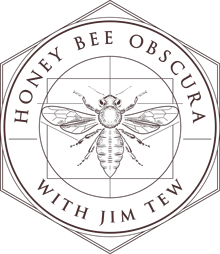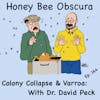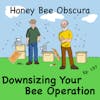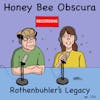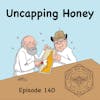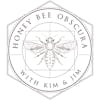Eating Honey (165)

Diving into the sweet yet challenging world of honey consumption, this week’s episode of Honey Bee Obscura delves into the nuances of enjoying honey—without the mess. Jim discusses the inevitable sticky spills that occur no matter how careful you...
Diving into the sweet yet challenging world of honey consumption, this week’s episode of Honey Bee Obscura delves into the nuances of enjoying honey—without the mess. Jim discusses the inevitable sticky spills that occur no matter how careful you are with honey. Whether it’s a drop missing the target or the complexities of enjoying comb honey and dealing with the leftover wax, Jim covers it all.
Jim also explores the best ways to store honey, debating glass vs. plastic containers, and addresses safety concerns, especially around reheating honey in plastic. He shares his personal take on granulated honey's texture, preferring it to the smoothness of liquid honey.
Historically, honey and comb were enjoyed together, with comb honey still celebrated today as the most "natural" form of honey. Yet, the question remains: how do you manage that bit of wax after enjoying the honey? This episode revisits forgotten social norms around consuming comb honey and offers insights into navigating the challenges of eating honey while highlighting its undeniable worth despite the extra cleanup effort involved
______________________
Thanks to Betterbee for sponsoring today's episode. Betterbee’s mission is to support every beekeeper with excellent customer service, continued education and quality equipment. From their colorful and informative catalog to their support of beekeeper educational activities, including this podcast series, Betterbee truly is Beekeepers Serving Beekeepers. See for yourself at www.betterbee.com
______________________
Honey Bee Obscura is brought to you by Growing Planet Media, LLC, the home of Beekeeping Today Podcast.
Music: Heart & Soul by Gyom, All We Know by Midway Music; Christmas Avenue by Immersive Music; original guitar music by Jeffrey Ott
Cartoons by: John Martin (Beezwax Comics)
Copyright © 2024 by Growing Planet Media, LLC

Episode 165 – Eating Honey
[music]
Jim Tew: Listeners, all of us who keep bees probably have had honey and honey production as a part of our beekeeping effort at one time or another. Well, here's some plain talk about that. I'm almost reluctant to get into it, but honey can be sticky, honey can be messy, and yet honey is one of the several backbones of beekeeping. I say this with love and with care sometimes it's tricky to eat. Let me spend a few minutes getting in trouble and then see if, by the time we end this conversation, I can mostly get myself out of trouble. Hi, I'm Jim Tew, I'm at Honey Bee Obscura, where once a week we talk about something you do with beekeeping one way or the other.
Introduction: Welcome to Honey Bee Obscura, brought to you by Growing Planet Media, the producers of the Beekeeping Today podcast. Join Jim Tew, your guide through the complexities, the beauty, the fun, and the challenges of managing honeybees. Jim hosts fun and interesting guests who take a deep dive into the intricate world of honeybees. Whether you're a seasoned beekeeper or just getting started, get ready for some plain talk that'll delve into all things honeybees.
Jim: Beekeepers, who has not had the squeak, squeak, squeak, squeak, sound as you walked across the kitchen floor, the extracting room floor? You just knew that somewhere along the way you've gotten a dollop of honey on the bottom of your shoe. If you don't know this yet, you certainly will come to know it, that you got to go back to every one of those steps and clean that floor flawlessly. One of the things I guess we have to address is that even though it's a remarkably natural delectable crop, honey is not always easy to eat. It's not always easy to maintain. It's not always easy to process.
Every conceivable kind of dipper, container, pouring device, whatever, and sooner or later, every one of them is going to lose a drop or more of honey on the table, on the floor, on your pant leg somewhere. Even though we love honey and it's remarkably good and goes on a lot of different foods and used in baking, and really has a spectacular reputation, it can really make a mess even in a small quantity. All of us have stories. If you've kept bees long enough, most of us have pictures. If you have time to make the picture in the heat of battle of what it looks like when you don't keep an eye on that extractor long enough and in most cases, that five-gallon bucket that you've got under the extractor exhaust valve overflows onto the floor.
You know when I was saying that my dad had a paint supply business and I grew up in his business selling paint supplies. I have seen paint do that. When I would see honey do that, and you use two pieces of cardboard or something stiff like that to pick up the honey, I would flash back to those old days that I was also picking up spilled paint in the same way. Things get spilled, it happens all the time, but with honey, it seems to have a lot of ramifications to it. Not only does it stick to you, it's also a very active food product. I went to the web trying to review myself and I-- this is as good a time as any to say, listeners, this is strictly a conversation. This is not a lecture. These are some of my life's experiences. I suspect you've had your own episodes, but I went to the web to try to get some idea, and it's just all over the page on what temperature honey should be liquified at re-liquified and the ways to liquefy it and what to do with it. It was extremely interesting to see all this happen.
Basically, 95 to 104 degrees Fahrenheit seems to be a common temperature for liquefying honey, because at that temperature, you don't break down the enzymatic systems. Others would routinely say 120, 125, just hot enough that you don't really want to leave your hand in the water. Listeners, it's been my experience that unless you're going to spend the better part of a day liquefying a quart jar of honey, it's going to take a fair amount of water and a fair amount of heat. With all respect, if Kim were here right now, he'd be kicking me under our virtual table because using that heat drives off the volatiles and the nuances of the flavor and over time, after you heat, heat, and reheat, we're basically just left with a honey-sweetened solution but the fine flavors of it are gone. I worry about that. I want that. I'm concerned about that.
A little bit like eating a fine food, drinking a fine wine or something. This delectable honey is supposed to be the best you can get. When it's just after dawn and I'm trying to get breakfast done and cleaned up and finished, I'm probably not thinking about the absolute most finest nuances of honey. I'm probably just thinking about the best way to get this product on my toast or my pancakes and eat it, get the whole thing cleaned up, and get out. I guess one of the points I would make from me personally is while I respect high quality, beautifully flavored honey, the other one of me on a more pedestrian day is just trying to get the honey on the food, cook with it, get it out of my measuring spoon, whatever it takes, and get on with it and get as many of the honey attributes as I can get.
When I began to try to check all these temperatures and whatever, it didn't really work out well. Basically, at least 104 and probably no more than 120 and keep an eye on it. One of the things do I dare bring this up. Plastic right now is really gotten a bright light on it. Plastic in our environment, plastic in our food life, plastic inside us, plastic everywhere. Well, I usually have to tell you how old I am in these discussions. I lived through beekeeping changing from primarily glass containers to plastic containers. The glass people didn't go without a fight. There were articles and magazines, there were discussions and talks at meetings.
I do wonder now, after 35, 40 years later, if those glass people are going to be more right than wrong because one of my daughters just is adamant that I'm not supposed to use the microwave for anything with plastic containers. I shouldn't be reheating that honey in a plastic container because it drives in microscopic amounts of plastic and some of the chemical processes that were used to make the plastic. I guess now I'm asking should we be using plastic containers to hold our honey when we liquefy it. I don't know. I will put that out there to cause confusion. It's one of the latter, most recent topics of plastic and plastic use. It hasn't been to my knowledge mentioned with honey, but I don't know why it couldn't be mentioned with honey. Do what you got to do to get that honey liquified again.
I guess I'd like to ask one simple, quick question. Is it okay with you folks if we just eat it granulated? I did that for about nine months. It's gritty, but it's so easy to do. There's no dripping, there's no nothing. You just scrape this stuff out, get through the sweet grit, dissolves on your pancakes. Everything worked okay. One of the points I'd like to leave with, if you want to take the path of least resistance, just slog through it granulated. If it's just you and you're a beekeeper, you know what's happening. That's not very delectable, is it? You're probably going to want to re-liquefy it, turn that back, and pour it on those pancakes in the morning, and feel good about things.
Let's take a short break, hear from our sponsor, and I want to change the theme here just a bit, but please come back. I've got more.
[music]
Betterbee: Now that your bees are cozy for the winter, let's turn up the heat with better bees mind-blowing classes led by the brilliant Dr. David Peck and the fantastic EAS Master Bee Keeper Anne Frey. These classes cover everything from beekeeping basics to advanced winter wisdom, whether you're a winter beekeeping beginner or a seasoned pro in the apiary. Our classes cover everything from snowy basics to advanced insights for winter beekeeping. Head over to betterbee.com/classes and unlock the secrets to upping your beekeeping game. Because at Betterbee, we're all about keeping you warm with knowledge all winter long.
Jim: I quickly looked and yes, you can freeze honey. Something that I have not done in single portion sizes I'm going to try to do. One of the articles said use a silicon ice tray and put it into single-source servings and then somehow get that out. It doesn't freeze like an ice cube, apparently, but I have not done this. I'm going to try it. Back when I was a honey judge, we were aware that people would freeze honey from one year to the next to try to get their really good entry to be available for a second entry the next year, not really legal but not horribly wrong, but yes, you can freeze it. Have a shot at that. See what you think about that.
Where I want to go on the second half is comb honey. It's different from extracted honey, but in many ways, it's precisely the same. I was intrigued when one of the suggestions for using comb honey was to put it on a charcuterie board along with the cheeses and olives and whatever else. I was thinking that if that's not at a beekeeper meeting, there's going to be a bit of awkward humor when someone's trying to ask what do you do with this dollop of beeswax that you're left with after you eat the honey out of the comb honey? While I was chuckling and envisioning how I would handle that conversation, it came to mind that sometimes olives have pits in them, cherries will sometimes have pits in them. There's other potential foods on the charcuterie board that may have something inside it that you need to remove from your mouth to a napkin with decorum and with dignity. Maybe that's all you do. Maybe you just chew it up. Yes, you can swallow it.
One of the most interesting things that has happened to me was I had what I think was a good luck to talk to a beekeeper who may have been one of the very last honey hunters of our times. Now I don't mean the very last one, but I mean the last of a generation. As a child in the Deep South, his dad would take his kids that go to a bush that had all these bees on it. They would dust the bees with nothing more than flour. Then when the bee took off, so did the kid. Then the kid would run as far as he could follow that white flying bee. The guy said that the bees were usually flying fairly low because he thought that they were laden with flour. He said sometimes you could follow them a great distance; other times you'd lose them right away. Ultimately, using nothing more than this, let me talk about this again some other time because he went into great detail about how this worked, but ultimately, these kids, mainly by sound, found a bee tree. Then they destroyed the tree. All those decades later, six, seven, eight decades later, this guy had been a beekeeper forever, and he said one of his concerns and one of the sad aspects of his life was how many bee trees they just destroyed and just left the bees on the ground with dead brood and destroyed the nest. The bees are on their own, and all they wanted was the honey. At that moment, listeners, he said, "We ate most of the honey. It was all over our hands. Chewed the wax up. Its brood mixed in. That was how we started and how we went back all those hundreds, thousands of years ago of/ just eating comb honey and enjoying it like that."
Now, we have these nice comb honey dishes. I did it. I put a nice piece of comb honey in that dish. I put it out when we had guests at breakfast, and we had a nice time. You can swallow all the wax. You can put it back in the napkin if you want to. It doesn't harm you. The honey is as good as it's going to be. It was a great conversation piece, listeners. The next day, maybe again. Next day, maybe again. Fifth, sixth, seventh, eighth day, a piece of comb honey begins to get ratty looking. What would you do? You see it's no longer this pristine delectable piece of food. Six, seven, eight days later, in that honey dish, that part of the honey that wasn't eaten is still fine but it just doesn't have that photogenic quality that you'd think it should have.
About that time, I guess I'd just say just eat it. You should not have left the honey there that long. You should have thought it was treated like it was a piece of meat in the refrigerator that had been left over. Got a day or two. Don't let the milk stay in there too long. I think we should treat comb honey in that same regard. It really is a nice food product that can come from that. It really is nicely edible but it does have a difficult aspect to it. Basically, we've lost that generation that I described a bit ago. We have lost that generation of people who readily unabashedly would eat comb honey.
For many years at Ohio State, we had a honey sale where we sold the honey from our bee lab. It was always in high demand, and we could have sold so much more than we could have produced. When we had comb honey there, it was really intriguing because we had to teach people how to eat it. It was almost comical the way the conversation would go. You see these people think about it, look at it, see the beeswax, ask if you could eat the beeswax. Yes, you can. What do you do with it? You swallow it. Then that's where the awkward questions begin to start. What happens then? Well, later on, you avoid it. It was a clumsy, awkward conversation because the generation that routinely ate comb honey is gone.
I wrote an article for one of the bee magazines some months back, and I mentioned comb honey and what to do with the leftover sections and whatever. A beekeeper wrote me and said he'd been producing comb honey for 25 years and that he had a lot of thoughts on this. Beekeeper can eat comb honey and not worry about it, so the comb is not perfect, not a big deal. You eat it. Now, the beekeeper eats it. If it's not a beekeeper who's eating it, it needs to be pristine, beautiful comb honey, or it's not going to be perceived as a food commodity. Then, as you would expect, the beekeeper said that he had ways for either extracting those unused combs or put it back on the bees, let them clean the honey out, and then melt the wax down. Everything was nonetheless in great shape.
Then he added a caveat that was unnerving, and it's along the same line of me having to educate people at the honey sale on how to eat comb honey. He said it really wasn't worth it that he was pushing uphill all the time. That 10, 15 years ago, he just converted everything to extracted honey. He was selling significantly more without the educational class that went along with it. Then he added this, if you want comb honey, it's all over the web. Just go to the web, do a search for comb honey and suppliers turn up everywhere. I did. They do. If you want comb honey, it's readily available. It's not cheap. It is the way that we all used to eat honey primarily before the development and the evolution of extractors and extracted honey and then moving from glass and metal containers to plastic containers where we are now in our honey crop.
As I wind this down, one of the things I guess I would say to you is that honey is going to granulate. By granulating, that's actually a good sign. It was not diluted. It wasn't cut. It wasn't adulterated. Honey naturally granulates at different rates, but most honeys are going to sugar as the wording is. Using heat, you can drive it back into liquid. I would suggest that as much as possible. You just eat it granulated. It's going to be very sandy, very gritty, but it'll have the same flavor, same taste. It just won't have the same texture.
When it comes to comb honey, it's going to have the wax. Yes, you're going to have to use a toothpick to get the wax particles off your teeth. Just do it. It's just honey. Honey has these unique characteristics about processing, holding, cooking, and eating that I suppose other foods have but at this very minute nothing comes to mind. My question now is, did I get out of trouble? Because I made it sound like honey just isn't worth it. Oh, it's absolutely worth it. It's absolutely worth it. Honey does have some attributes that are demanding and require us to be alert and aware on how we store and eat this product as really one of the finest most natural products available to us.
Want to go back tomorrow morning, again, and put honey ack on my toast just like I did today and I'll complain about how you have to be very careful not to get that one drop on the table, on the bottom side of the plate, and then here the mess goes all over again. Thank you so much for listening. I'd like to talk to you again next Thursday if you've got time. Bye-bye.
[00:20:30] [END OF AUDIO]
New to Honey Bee Obscura Podcast?
Here are some great episodes to start with. Or, check out episodes by topic.







 Diving into the sweet yet challenging world of honey consumption, this week’s episode of Honey Bee Obscura delves into the nuances of enjoying honey—without the mess. Jim discusses the inevitable sticky spills that occur no matter how careful you are with honey. Whether it’s a drop missing the target or the complexities of enjoying comb honey and dealing with the leftover wax, Jim covers it all.
Diving into the sweet yet challenging world of honey consumption, this week’s episode of Honey Bee Obscura delves into the nuances of enjoying honey—without the mess. Jim discusses the inevitable sticky spills that occur no matter how careful you are with honey. Whether it’s a drop missing the target or the complexities of enjoying comb honey and dealing with the leftover wax, Jim covers it all.
